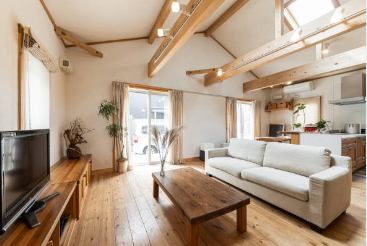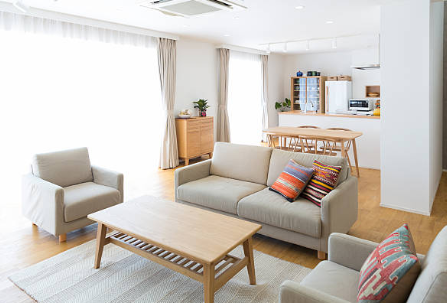Ever wanted to bring a sense of zen into your living space? Japanese decor is all about simplicity, natural materials, and harmonizing with your surroundings. You don’t need shoji screens or tatami mats to channel that minimalist vibe – just a few small touches can transform your home into a calming oasis.
In this article, we’ll show you some easy ways to incorporate Japanese-inspired style into your home decor. We’re talking bamboo plants, origami art, natural wood accents, and muted earthy tones. These subtle additions can make a big impact without overpowering your existing decor. So find your inner peace, grab some inspiration from the land of the rising sun, and get ready to turn your place into a little slice of solitude. Your home will thank you for the zen makeover!
Incorporate Japanese Minimalism With Clean Lines and Neutral Colors

To get that minimalist Japanese vibe, stick to clean lines, neutral colors, and natural materials. Think light wood, bamboo, rice paper, and tatami mats.
Keep furnishings low and multipurpose.
Opt for floor seating like zabuton cushions, low tables, and foldable floor chairs. A kotatsu – a low, heated table – is perfect for staying cozy in the winter. For sleep, futons, foldable mattresses, are ideal.
Choose natural and neutral colors
Off-whites, beiges, light browns, and pale grays work well. Accent with pops of red or forest green. For walls, keep them bare or use textured rice paper.
Bring in natural light
Open up your space with large windows, sliding doors, and skylights. Layer up with translucent window coverings like shoji screens, rice paper blinds, or linen curtains.
Add decorative touches
A bonsai tree, ikebana flower arrangement, hanging scroll, or wall tapestry can go a long way. Lanterns, wind chimes, and tatami mats also help complete the look.
Keep clutter to a minimum
Have a place for everything and store items out of sight when not in use. A clutter-free home allows the natural and decorative elements to shine through for a peaceful ambiance. With a few simple principles, you’ll be channeling the essence of Japanese style in no time.
Add Authentic Japanese Accents Like Bonsai Trees, Bamboo, and Shoji Screens

Add authentic Japanese accents to create a calming ambiance. Some simple touches can transform a space.
Bonsai trees are miniature living works of art. Their sculpted shapes represent harmony between nature and art. Even a single bonsai placed in a decorative pot will make a statement.
Bamboo is another iconic plant. Bamboo stalks in a simple vase or bamboo mats and fencing incorporated into decor provide natural texture.
Shoji screens, latticed room dividers made of wood and rice paper, filter light beautifully. You can find traditional shoji screens or modern versions with metallic frames. Screens give a sense of separation without closing in a space.
Bring Japan Home with Art and Accessories
Paintings of Mount Fuji, cherry blossoms or koi fish reflect Japanese culture and esthetics. Hang a traditional folding fan or kimono on the wall for a decorative touch.
Place a zen garden in a shallow dish, with white sand and a few artistic rocks. Rake the sand into patterns for a calming effect.
Lanterns, whether stone, metal or bamboo, shed a soft glow. Group several lanterns together or line a walkway.
Decorative bowls, trays, vases and baskets handcrafted from natural materials showcase the Japanese mastery of form and function. Fill them with pebbles, moss, or blooms for an artistic still life.
With selective accents in a minimalist style, you’ll create a peaceful oasis reflecting the essence of Japanese design. Simplicity,
and tranquility will surround you.
Create Zen-Inspired Rooms With Natural Materials and Soothing Textures

Natural, organic materials and textures are key to creating zen-inspired spaces. Focus on wood, rattan, cotton, linen and other breathable, soothing fabrics.
Use Natural Wood
Wood adds warmth and connects you to nature. Look for wooden furniture, flooring, accents like bowls or trays. Teak, bamboo and unfinished woods have beautiful grains.
Add Wicker or Rattan
The open, airy feel of wicker or rattan complements the zen style. Use it for chairs, tables, baskets or decor. The light, wispy texture is calming.
Select Peaceful Fabrics
Natural, organic fabrics like cotton or linen are ideal for bedding, cushions, drapes or upholstery. Their rumpled, casual look and feel is soothing. Avoid anything too shiny or slippery.
Bring in Natural Light
Open up your space to natural light as much as possible. Use sheer drapes or blinds and position furnishings to maximize light from windows. Natural light boosts mood and connects you to the outdoors.
Keep Things Simple
A minimal, uncluttered environment is most conducive to zen. Pare down furnishings and decor to the essentials. Clear surfaces and an open layout create a sense of space and calm. Too many bright colors or competing patterns disrupt the zen feeling.
Add Greenery
Houseplants or small indoor trees help oxygenate and freshen indoor air. Their natural, living presence enhances the zen quality of a room. Choose plants with round, flowing shapes like ferns, orchids or succulents.
With natural materials, muted tones, minimal decor and an infusion of greenery, you’ll cultivate a peaceful, zen retreat in your own home. Simplicity, nature and tranquility are the guiding principles to create a harmonious space for mind and body.
Conclusion
So there you have it, a few simple ways to incorporate Japanese-inspired decor into your home. Don’t feel like you have to overhaul your entire space or spend a fortune to achieve a minimalist yet cozy look. Start with a few key pieces you love, pay attention to natural materials and an uncluttered feel, and build from there. Your home should be a peaceful retreat, a place that sparks joy. If a bonsai tree or a bamboo mat or a silk kimono does that for you, embrace it! Your space, your style. Just keep things balanced and remember that in Japanese decor, less is more. Take a deep breath and enjoy creating your own Zen.

